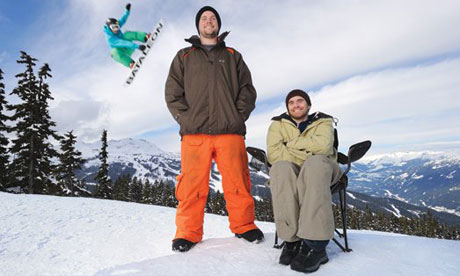
Seven years ago, engineering student and budding pro-snowboarder Aaron Coret had an accident that left him paralysed from the neck down after crushing two vertebrae. With the help of his fellow student Stephen Slen he designed a landing pad so that snowboarders could practise jumps without risk of serious injury. Last year, their company, Katal, won an innovation award from Popular Science.
Your landing pad was inspired by your accident. Can you tell me how it happened?
I was attempting a 50ft jump at Whistler Blackcomb, a Canadian ski resort, and I came off the lip and immediately lost control as I flew through the air. It was a jump I'd done before and I thought everything was going to be fine. But as soon as I touched the ground my entire body went numb. Then, when I finally came to a stop at the end of the landing, I knew what had just happened. I knew I had broken my neck and my life had changed for ever.
Some people who'd had an accident like that would never want to look at a snowboard again.
Snowboarding is still in my blood – I think about it all the time. And I sincerely believe that one day I'll be able to do it again. But this is just a kind of detour that I'm taking. At first, right after my accident, it was hard to think about it, but now I'm totally engaged in it, as much as I was before. Just with a different perspective.
The idea came to you in hospital?
Yes. The idea of a landing pad that would allow people to try tricks in a safe environment really clicked with me; I was immediately very passionate about it. It's something I wish now I could go back and use – that would be my ultimate dream. But now I get to share my ultimate dream with everybody else.
So until now, tricks and jumps have been practised without a safety net?
Yes, normally you just go to a training park – which is hard-packed or icy snow. Basically, you just give it a go. But if you make one mistake, you have to pay for it. That's the reason a lot of people don't try a lot of the tricks they have in their heads – because the risks are too high. When they do, there are usually high consequences because of very small mistakes, as I know.
How long were you in hospital?
I was in Vancouver general hospital for about 40 days, then I was transferred to a rehabilitation centre for six months. After that, I went back to school; the year started right after I finished rehab. I went back to engineering. After my second year back, me and my best friend, Stephen, who is now my business partner, made the prototype of our pad as our final fourth-year design project.
What was the biggest challenge for the design?
When we first started, we thought, like most people, that the cushioning chamber had to dump air when the rider hits the airbag, so that the changing of air volume provides the cushioning.
But after our first two designs, and watching the video over and over, we realised the reason our pad was actually working was not because when someone hit the bag it was dumping air when it hit – actually it was already slightly deflated.
So now we basically have a slow leak, so that when the guy hits, the air has room to move inside the chambers. We've got air pumps constantly inflating the thing because it is not permanently sealed; there are air releases that control the amount of air being let out. So there is a constant cycle.
Is it true a company that makes bouncy castles manufactures them for you?
Yeah, those are the industry guys who are most experienced with stitching and inflatables construction. They are the experts who have the experience to put this together. The landing pads are made from high-density vinyls. We make the actual structure from the highest tear-resistant vinyl you can get, which is 18.5oz vinyl. But for our top sheet, because ski edges are pretty sharp, we use an extremely tough and slick surface that is replaceable, so that if it gets damaged over the years they can basically rip it off and put on a new one.
What has the feedback been like from the snowboarders who have tried the pads?
Oh, it's been incredible! Everybody absolutely loves the thing. Yet it's been a slow start for us. Resorts have been slow to come around to airbags. Three years ago, when we started up, we wanted to do a tour of resorts, but no one would even let us on the hill! But now we've made a lot of progress. Resorts have seen that air-bags are actually legitimate safety-mitigation tools. We are getting a lot of interest from all over the world. We just sold our first airbag to a resort in Russia called Kirovsk.

